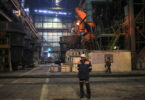I.M. Kiyani
In Dec 79, Soviet tanks and troops marched into Afghanistan making victory symbols. The US grabbed this rare opportunity and pumped in millions of dollars. The Afghans then called Mujahideens, were rendered whole hearted support to wage the Holy War against the invading Soviet Army. After about 10 years of blood bathing, the Soviet Army was again seen making victory symbols but this time for safe exit to back home. The US turned her face too and Afghanistan got bogged in civil war.
As Afghanistan was getting little stable, the 9/11 came. The US, with all its military might and fury, disregarding the history and ground realities came heavily on Afghanistan, apparently for eradication of terrorism. As the years passed, US also made attractive promises of democratisation and reconstruction.
The US soon got entangled in an unending so called “Global War on Terror”. With the multiplication of miseries for Afghanistan, US led NATO’s Resolute Support (RS) Mission also expanded to 41 countries (27 NATO allies and 14 operational partner nations), the largest wartime coalition.
Thousands of casualties and an expenditure bill over $ 1.3 trillion, calls for realistic analysis. What all has been achieved for the world community, the US, RS Mission members, the regional countries and Afghanistan, from the longest war that any country has ever faced in modern times.
The Afghan war enters it 18th year with reports of stalemate. Critics are of the view that “to be in stalemate means defeat for a superpower”. The US led RS Mission preferred to hold main urban communication centres and major roads. They heavily relied on aerial power which clearly meant adverse situation on ground. They never had sufficient troops to fight, defeat and hold the territory, rather the war was mostly fought from the comfortable cabins, hundreds of miles away. These fundamental follies largely contributed to the present situation.
The fatalities in Afghanistan stand over 1,50,000 people. Approximately 6334 American soldiers and contractors, as well as more than 1100 allied troops have been killed. 20,320 US troops suffered severe injuries. The number would well exceed 1 million if indirect deaths are included. Casualty rate of Afghan National Army (ANA) trained by RS Mission, sky rocketed to 1000 men a month. ANA has lost over 28,000 troops in last three years as they have been put in front to take the brunt. Critics are of the view that if ANA has to fight and accept extremely heavy casualties then its time for RS Mission to roll back.
Millions of soldiers have suffered traumatic brain injuries. According to a study by Veteran Affairs (VA) in 2016, on average 20 US veterans commit suicide each day. A report published by The Guardian in Sep 2018 confirms that more than 6000 US veterans have killed themselves each year since 2008. Analysts say the cost of veteran’s medical and disability payments over next 40 years would be around one trillion US dollars. The Narco terrorism continues to flourish as ever. Special Inspector General for Afghanistan Reconstruction (SIGAR) in its June 2018 report states that despite US spending $ 8.62 billion, it remains the world’s largest opium producer. Poppy cultivation and opium production reached record high in 2017.
President Trump’s pullout decision has attracted mixed views. Few are calling it “a punch to the gut” for the US negotiators, where as majority is of the view that the bold decision has created a wave of excitement among pacifists across the world. But ever strong people behind Industrial Military Complex and war mongers in Washington are trying their best to distract Mr Trump.
The world community must consider the helpless Afghan masses who have been subjected to an endless war which has caused them unimaginable deprivation for about four decades. Their almost four generations have been put to test. Afghan refugees are spread all over the world.
Let us make a sincere effort for their dignified return to a secure and promising home. The US may also realize that democracy cannot be exported through B-52s. It is fallacious to think that the US forces are a must for the stability of Afghanistan or for that matter any country or region of the world. The US still has the opportunity to consider what Andrew Bacevich said in simple words “War in Afghanistan began with an illusion that it was incumbent upon the US to liberate and transform that country. The war in Afghanistan will end, as the Vietnam War ended – in shame and abandonment.” The US may also recall what a Taliban Commander said to a NATO general in 2011 “You have the watches, but we have the time”.






